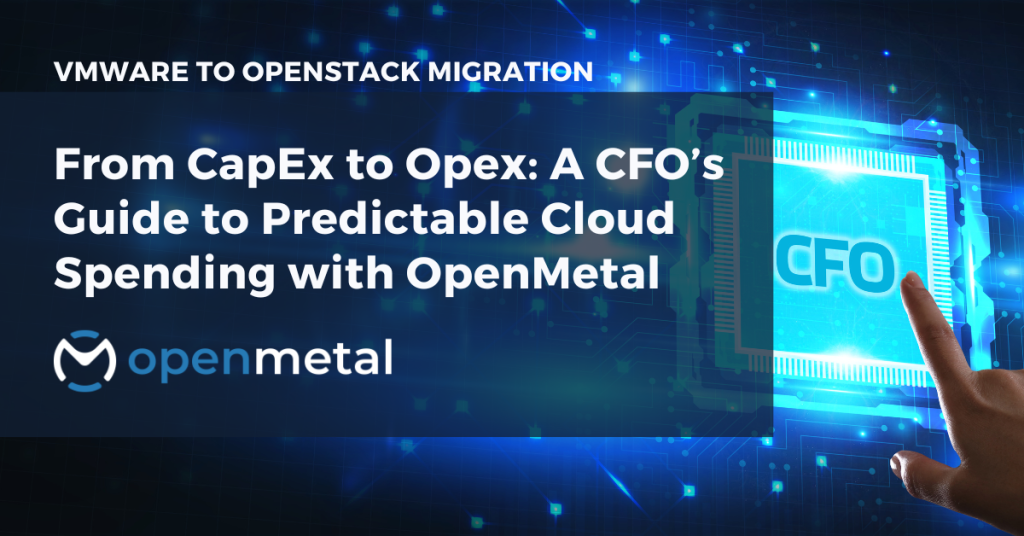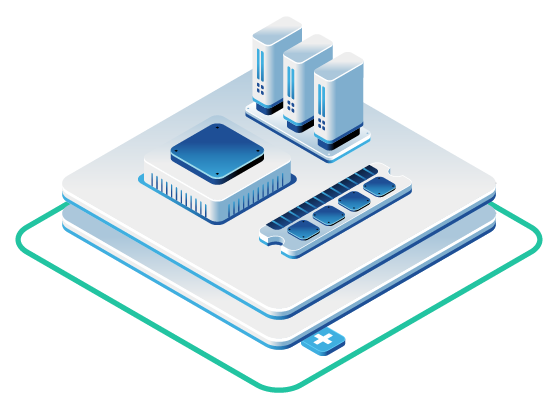
Rising VMware costs unsustainable?
The OpenMetal team is standing by to assist you with scoping out an OpenStack based fixed-cost cloud to fit your budgets and timelines.
As a CFO or finance leader in IT, you face a balancing act: delivering innovation on a budget that doesn’t spiral out of control. Yet today’s cloud landscape often seems designed to undermine predictability. For example, after Broadcom’s acquisition of VMware, some renewal quotes shot up by as much as 500%, blindsiding finance teams. Meanwhile, public cloud bills have become an “accounting nightmare” as costs balloon in opaque ways – roughly one-third of cloud spend is wasted on idle resources.
Given these challenges, controlling IT costs might feel like an uphill battle. However, you can shift from volatile capital expenditures (CapEx) to a stable operating expense (Opex) model for infrastructure.
This guide will show how adopting OpenMetal’s fixed-cost private cloud (built on OpenStack and Ceph) can bring predictable cloud spending and cost transparency to your organization’s cloud budgeting.
The CapEx Burden of VMware and Legacy Infrastructure
VMware type traditional models often hits you with large periodic costs – from hefty license renewals to hardware refreshes – that spike IT spending in certain years. The recent Broadcom–VMware shakeup highlighted this risk: by early 2024, VMware customers began receiving eye-watering renewal quotes, in some cases up to 5× higher than before. Such steep, sudden increases wreak havoc on budget planning. A significant portion of VMware’s cost comes from software licensing (about 43% of VMware’s revenue in 2020), and analysts worry Broadcom’s push toward subscription licensing will further raise costs while limiting discounts.
Additionally, proprietary platforms like VMware create vendor lock-in that restricts your flexibility. If VMware raises prices or changes terms, you’re stuck unless you undertake a costly, time-consuming migration – something few organizations can do quickly. It’s no surprise Gartner advised VMware users to “identify exit ramps” and explore alternative solutions in light of the Broadcom deal. The bottom line for CFOs is clear: a CapEx-heavy strategy tied to one vendor carries significant financial risk and volatility.
For many, the logical response is to explore open-source alternatives. In fact, over 80% of OpenInfra Foundation members report that organizations have asked about migrating workloads from VMware to OpenStack since the re-licensing announcements. This surge of interest underlines a growing trend toward solutions that promise more cost control.
The Unpredictable Bills of Public Cloud
Shifting from CapEx to Opex with hyperscalers isn’t a panacea either. Public cloud costs are famously difficult to forecast – what starts as a convenient pay-as-you-go model can quickly turn into a budgetary minefield. Industry research shows cloud prices continue to rise (outpacing inflation), and managing cloud spend is now the #1 cloud challenge for organizations. On average, an estimated 30% or more of cloud spend is wasted on resources that aren’t even used.
For a finance leader, these unpredictable bills are a nightmare. A slight uptick in usage or an overlooked service fee can blow through your budget with little warning. Hidden “gotchas” like data egress fees compound the problem – moving data out of a public cloud can incur hefty charges (often ~$0.08–$0.12 per GB), leading some companies to rack up $80,000+ per month in outbound data fees. Andreessen Horowitz famously observed that at scale, public cloud “can at least double your infrastructure bill” compared to running your own equipment. In short, the public cloud’s variable Opex model may eliminate CapEx purchases, but it often trades one form of unpredictability for another.
OpenStack and OpenMetal: A Predictable Opex Alternative
This is where OpenMetal’s model enters the picture as a breath of fresh air. OpenMetal delivers a private cloud powered by OpenStack (the open-source cloud platform) as a service – but with a radically transparent, fixed pricing approach. In essence, you get the agility of cloud with the cost stability of owned infrastructure. Here’s what sets it apart:
No Costly Licensing Fees
OpenStack is open source, so you’re not paying VMware-style license premiums. This removes the perpetual license churn (and sticker-shock renewals) from your cost structure entirely.
Dedicated Resources at a Fixed Rate
With OpenMetal, you’re provisioned a known quantity of hardware for a flat monthly fee. That means no meter is running on CPU hours or I/O – your cloud costs stay the same month to month regardless of usage spikes.
Transparent Pricing, No Surprises
OpenMetal publishes a public pricing calculator, allowing you to configure exactly what your private cloud will cost in advance. There are no hidden line-item charges for API calls or storage IOPS. You can even set budget thresholds to prevent any accidental overages. The result is full cost visibility before you commit – you know exactly what you’ll pay, every billing period.
Lower Total Cost at Scale
By avoiding the “cloud tax” of usage markups and waste, OpenMetal’s private cloud can deliver 30–60% lower TCO once you reach a certain scale of usage. Many organizations report real-world savings around 50% versus comparable public cloud spend by eliminating surprise overage fees and proprietary license costs.
Predictable Bandwidth Costs
Unlike hyperscalers, OpenMetal doesn’t punish you with unpredictable egress fees. Generous bandwidth is included, and any overage is billed at a flat rate (95th percentile model), similar to traditional colocation – a far more predictable approach than per-gigabyte charges.
In practice, this model transforms your infrastructure spend into a budgetable, steady Opex item. It’s akin to leasing a fully managed, private cloud data center that you control, but without any usage-based billing surprises. You get the performance and security benefits of a single-tenant private cloud, with the financial predictability that your finance team will appreciate.
It’s also worth noting that because OpenStack is vendor-agnostic and widely supported, you avoid being trapped by any single provider’s whims. If needed, you could migrate your OpenStack workloads to another OpenStack service or on-premises hardware with far less friction than exiting a proprietary platform. This flexibility further de-risks your long-term IT spending by ensuring you’re never again at the mercy of one vendor’s pricing strategy.
A very Public Case Study: How GEICO Made the Switch
Consider GEICO, one of the largest auto insurers in the U.S. In 2024, GEICO made headlines by deciding to migrate off VMware to OpenStack for its cloud infrastructure.
As GEICO’s Distinguished Architect Tad Van Fleet explained, the move was driven by a need for greater control and to escape the limitations of proprietary systems. Before the migration, GEICO’s team took the time to “right-size our environment to eliminate over-provisioned resources. This allowed us to reduce the number of physical servers and streamline our infrastructure,” Van Fleet noted. In other words, they identified and cut out waste to immediately lower costs, even before fully transitioning to OpenStack.
GEICO isn’t alone. They joined a long list of major enterprises (Walmart, Target, Nike, and others) that use OpenStack to run mission-critical workloads. The takeaway is that with proper planning, even large organizations can successfully break free from VMware’s cycle of CapEx and unpredictable costs. OpenStack’s maturity – and the availability of managed OpenStack providers like OpenMetal – makes this transition viable and financially attractive. In GEICO’s case, the reward for navigating a complex migration was a more flexible, cost-efficient cloud footing for the future. Their experience demonstrates that the short-term effort of migrating can be justified by long-term savings and stability.
A CFO’s Action Plan for Predictable Cloud Spending
Shifting from CapEx-heavy or volatile cloud spending to a predictable Opex model requires strategy. As a CFO, you’ll want to work closely with your CIO and IT leaders on a phased, well-justified approach. Below are key steps to guide your planning:
Audit Your Current Costs and Risks
Begin with full visibility into your existing VMware and cloud expenditures. Identify when major contracts or renewals come due – for example, mark the end dates of VMware license agreements or reserved cloud instances. This gives you a timeline for change. Also, quantify any “budget busters” on the horizon (like an upcoming VMware renewal that could jump in cost) and assess the extent of cloud waste (e.g. idle VMs or oversized instances). Knowing where your money is going today is the baseline for any improvement.
Eliminate Over-Provisioning
Before any migration, work with IT to right-size workloads and eliminate excess capacity. This means addressing over-provisioned VMs, cleaning up unused storage, and consolidating underutilized servers. (GEICO’s team did this upfront, allowing them to reduce their physical server count and trim costs even before cutting over to OpenStack.) By cutting out waste now, you ensure that when you move to OpenMetal’s fixed-cost cloud, you’re only paying for what you actually need – and you’re not carrying yesterday’s inefficiencies into tomorrow’s platform.
Compare CapEx vs. Opex Scenarios
Build a clear financial model for the next 3–5 years under different strategies. What does status quo – renewing VMware or staying all-in with public cloud – truly cost when you factor in growth and likely price increases? Then model a move to OpenMetal’s fixed-cost private cloud. Be sure to include all relevant costs, but also acknowledge which costs would disappear (for example, proprietary licensing fees and unpredictable overage charges would be gone). Often, this exercise reveals a compelling reduction in Total Cost of Ownership (TCO) with a private OpenStack cloud, especially when accounting for the ~30–60% savings at scale and the avoidance of surprise fees. Translate these differences into budget impact and risk terms that the board will understand (e.g. “this plan would save $X million over 5 years and eliminate the risk of 5× renewal spikes”).
Run a Pilot Project
Encourage your IT team to test the waters with a proof-of-concept deployment. OpenMetal makes it easy to launch a trial OpenStack cloud or a small pilot cluster to validate how the platform performs with your workloads. This trial should be used to verify integrations, gauge learning curves, and measure actual costs in practice. From a finance perspective, a pilot is a low-risk investment that can confirm projected savings and surface any one-time migration costs. The insights from a pilot will strengthen your business case and give stakeholders confidence that a larger migration can succeed.
Plan the Transition and Get Buy-In
Work cross-functionally to draft a migration plan that mitigates risks. Time the larger cutover to coincide with contract expirations or hardware end-of-life, so you’re not double-paying for old and new environments longer than necessary. Ensure that support and training are part of the plan – allocate budget for upskilling staff on OpenStack or consider partnering with a managed OpenStack provider for expertise. Internally, present the plan emphasizing predictable budgeting and improved cost control. Frame it as a strategic upgrade: you’re moving the company to a cloud model that eliminates billing surprises and aligns with the CFO organization’s goals of cost stability and transparency. Gaining executive and stakeholder buy-in will be easier when they see this not merely as a tech migration, but as a financial optimization initiative with clear business benefits.
By following these steps, you can steer your company toward a cloud infrastructure that’s not only technically sound, but also financially stable. In the end, you should be able to forecast your infrastructure costs with a high degree of confidence. The next time you’re reviewing budgets, your cloud line item can be a fixed, predictable figure rather than a volatile question mark.
The Bottom Line for Finance Leaders
In an era where IT spend can make or break budgets, predictability is power. Moving from CapEx to Opex with a solution like OpenMetal’s hosted private cloud gives you predictable costs without sacrificing performance or agility. Instead of dreading the next true-up or surprise invoice, you can forecast infrastructure expenses accurately and allocate funds more strategically.
By embracing open-source technology and a fixed-cost model, you’re essentially hedging against vendor-driven price shocks and usage-driven overruns. The result is a more finance-friendly cloud – one where you stay in control of costs, enjoy full transparency, and still meet your organization’s IT needs. For CFOs and finance teams, that means finally delivering cloud cost certainty to the business.
Are you ready to transform your cloud spending into a stable, forecastable part of your budget? The tools and partners are in place to make it happen – and the peace of mind that comes with cost stability is well worth the journey
Migrate from VMware to OpenStack
Questions? Schedule a meeting or start a chat.
Note: We would like to make this article as comprehensive and accurate and possible. If you have any suggestions for improvements or additions please feel free to send them over to marketing@openmetal.io.







































